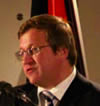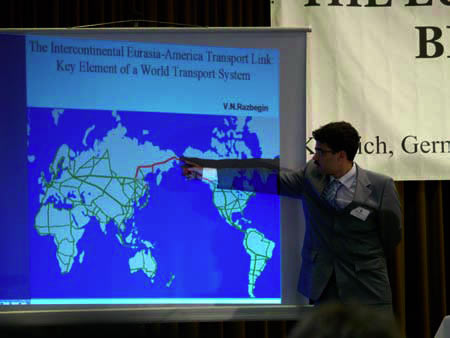
Yuri Krupnov
Stuart Lewis, EIRNS

Ilnur Batyrshin
Helene Möller, EIRNS
September 15-16, 2007
Kiedrich, Germany
Space Industry Cluster In Russia's Amur Region
Ilnur Batyrshin, Yuri Krupnov
(Download MP3 audio) (Download Power Point slide show)
Yuri V. Krupnov, director of the Institute for Demography, Migration and Regional Development, submitted a presentation on the Svobodny Cosmodrome to the conference. A Russian specialist in education and industrial project development, especially in the area of infrastructure, Krupnov is the founder of the Development Movement and its political wing, the Development Party. In the very recent period, Krupnov has served as an advisor to government officials in the Russian Far East, concerning highly dense economic corridor development.
The youth section of the Development Movement is called the World Development Movement (WDM). Ilnur Batyrshin, head of the WDM's chapter in Kazan, Russia, delivered and slightly expanded Krupnov's briefing at the conference. The full title was "Svobodny Cosmodrome: a Potential Space Industry Cluster and Development Corridor in Russia's Amur Region."

EIRNS/Julien Lemaître
Ilnur Batyrshin is head of the World Development Movement youth organization
in Kazan,
Russia. Here, he presents Yuri Krupnov's briefing to the Schiller
Institute
conference.
The situation in the Far East of the Russian Federation looks like a disaster. There are serious problems with transport infrastructure. A lot of industries are destroyed, and even the buildings of many factories have been destroyed to the ground.
But the most serious problem, the deadly problem of the Far East, is the continuing depopulation of the region. Today, only 18 million people live in the Far East, and each year this number is decreasing.
This presentation, on the potential development of the Svobodny space launch site in the Amur Region, in Russia's Far East, contains a set of proposals for the government program on promoting voluntary resettlement in the Russian Federation, of former residents now living abroad.
Having this problem in mind, President Vladimir Putin said to the State Council of the Russian Federation on Dec. 20, 2006: "Ultimately, all our plans must aim to make the Far East a comfortable and attractive place for people to live."
This presentation contains some ideas and practical suggestions to support the decision of the President and to reverse the outflow of Russian citizens from the Far East, in favor of internal immigration: an influx of population from the western regions of Russia, as well as our compatriots living abroad.
The goals of such a state program will be to reverse the depopulation of this area and to create skilled manufacturing jobs. The combined result will be to achieve a higher population density and skill level in this area along Russia's border with China.
The population density in the Amur Region, a main region of the Far East of the Russian Federation, is 2.4 people per square kilometer, compared with 80 people per square kilometer, across the Amur River in China's Heilongjiang Province.
The objective of this program is to increase the population density in the Amur Region to a range of 2.8 to 3 people per square kilometer. This means growing from 873,000 people at present, to 1 million. It should happen within five years.
In order to launch intensive development of the Amur Region, creating tens of thousands of new high-skilled jobs, the new governor has announced that five clusters will be organized, in the following economic areas: the timber industry; the space exploration industry; machine-building; soybeans; transport and energy.
In 1995-96, Russia's Ministry of Defense, the General Staff of the Armed Forces, the Russian Space Agency, and other ministries and Federal agencies, chose Svobodny in the Amur Region as the location for a new space-launch facility. Nearby, is a military settlement called Uglegorsk. The transformation of the Svobodny launch site into a full-fledged space center could become the core of the project to resettle the region.
The Svobodny Cosmodrome would have great advantages:
* First and foremost, the highest concentration of skilled specialists in the eastern half of Russia, an area covering five time zones;
* Its location at 52° North latitude, the most advantageous in Russia for space launches;
* A great range of available angles of launch, from 51 to 110°;
* Convenient empty Launch Hazard Areas;
* A practically unique capacity, in Russia, for Sun-synchronous satellite launches;
* Capacity for launching geostationary satellites and for manned spacecraft launches.
A strategic vision of the Svobodny Cosmodrome could be expressed this way: "The first truly Russian Cosmodrome—a new, full-function, main national cosmodrome."
Since its creation, the Svobodny launch site has launched satellites on a commercial basis, including for U.S., Swedish, and Israeli customers. Now it should aim to be the best in the world, launching military and commercial satellites into geostationary or non-geostationary orbits, as well as manned spacecraft.
The Svobodny site continues to be important militarily. It provides guaranteed access for Russia to outer space, as well as the ability to monitor what we call World Strategic Region #1, the western Pacific Ocean along the coast of China (Figure 1).
Figure 1

Uglegorsk-Svobodny is at the large white dot near the top of the map.
In addition, developing Svobodny opens up the potential to revive the Baikal-Amur Mainline (the BAM railroad) as a back-up transport system in the region, with construction of a 220-kilometer lateral rail line between the BAM and the Trans-Siberian Railroad, through Uglegorsk.
The future of the Svobodny facility and Uglegorsk has not yet been decided. They could be shut down. This first option would take away 5,100 inhabitants of the Amur Region and waste the 7 billion rubles of infrastructure investment that already went into Svobodny. The second option is that they might be maintained on the relatively small scale of their activity in recent years.
Or, the third option, which looks more attractive and more promising, is to create the first Russian National Cosmodrome. (The Soviet Union's space program, as you may know, used the Baikonur Cosmodrome, which is located in Kazakstan. Russia now rents Baikonur from Kazakstan.)
In this version, Svobodny would be the site of a full-fledged Russian space travel center, launching Zenith-type delivery rockets, as well as the reusable space shuttle that is now called the Clipper.
The Zenith rockets are produced in the nearby city of Komsomolsk-on-Amur. The Svobodny Space Cluster and the Eastern Development Corridor "Svobodny-Komsomolsk" can become the industrial and technology base for the development of the Russian Far East. By "cluster," we mean unique, geographically concentrated groups of inter-related companies and organizations, suppliers of goods and services, companies in related sectors of industry, and also R&D organizations and educational institutions.
I would like to add that this region, the Far East of the Russian Federation, plays an important role for the Eurasian Land-Bridge and for the project of constructing a tunnel through the Bering Strait. The problems of this region—its continuous depopulation, and other problems—are a threat to this project.
Figure 2

The Eastern Development Corridor would run eastwards from Uglegorsk to Komsomolsk-on-Amur, toward Sakhalin Island and the Pacific Ocean (Figure 2). This corridor defines a platform for the industrial development of the Far East on the basis of innovation. Developing the Uglegorsk-Komsomolsk corridor will be an incentive to revitalize and modernize the BAM railroad, and to launch industrial growth in the Amur Region and Khabarovsk Territory. In this process, it will create markets for new steel industry facilities in the region (using the Garin iron ore deposits) and other metals production, whose expansion will be the basis for doubling or tripling the population of the corridor area in the next ten years.
The corridor will become a platform for the development of the entire Far East on an innovation basis. From the Eastern Development Corridor, it is natural to build a bridge or tunnel across the strait to Sakhalin Island, Russia's district that reaches down to Japan's northern island of Hokkaido. So, this project could help Japan become connected with the project by railroad lines.
The proposed Far East space cluster would be unique in the whole world.
Organizing this cluster will create well-paid jobs, which can attract our compatriots living in Western Europe, America, and Canada, as well as new graduates of Russian universities. Development of the space industry in the Amur area and the Far East, at higher than average rates of growth, will create demand for the skills of engineers, designers, and scientists from cities east of the Ural Mountains, such as Tomsk, Novosibirsk (with its science center of Akademgorodok), Omsk, and Krasnoyarsk. It will help to stop the brain drain from Siberia, and from Russia as a whole.
If we create a launch center for light rockets and nanosatellites, we shall be able to increase the population of the town of Uglegorsk from its present 6,000 residents, to 15-20,000 people, within ten years.
If we go for the maximum program of building Russia's first national cosmodrome, we could increase the population around Uglegorsk to 50 or 70,000 people.
Development of new manufacturing for the full cycle of space industry production and services around the Svobodny Cosmodrome would mean the creation, on the basis of the Komsomolsk Aerospace Company and the Shipbuilding Factory in the same city, of over 30,000 skilled jobs, and at least 60,000 semi-skilled jobs. The population growth, including workers and their families, would be 120,000 people, while the population of Komsomolsk-on-Amur could increase from its present 270,000, to 500,000 people.
Uglegorsk has the infrastructure for starting to develop the space cluster, including excellent housing and other social infrastructure, with some vacant apartments already available. Construction of additional housing in the form of one-story wooden buildings will create a market for the local timber industry.
Figure 3

Four hundred meters from the entrance to Uglegorsk runs the Federal highway from Chita to Khabarovsk (Figure 3). The nearby railroads are the Trans-Siberian Railroad to the south, just 1 kilometer from Uglegorsk, while the BAM parallels the Trans-Siberian, but it is about 220 kilometers to the north. Nearby are two regional airports, and a full-scale airport at the Ukrainka strategic bomber base, as well as a shipping terminal on the Zeya River, which links Svobodny with the Port of Blagoveshchensk and other ports on the Amur.
Also running through this corridor is the new East Siberia-Pacific Ocean oil pipeline, which is under construction 20 kilometers from Uglegorsk. Paralleling it in the area is the electric power transmission line from the Bureysk and Zeya hydroelectric power stations, which is 3 kilometers from Uglegorsk.
Russian law provides for the creation of Special Economic Zones, which would be an optimal approach to the creation of this high-technology cluster. A space industry-centered Special Economic Zone will attract Russian and foreign investment. Besides China, foreign partners could include Singapore, South Korea, and Japan.
The key problems to solve, in order to create this space industry cluster, are the retraining and assignment of former offices; proper use of Ministry of Defense assets; and, related questions of interaction between the Ministry of Defense and civilian agencies.
The skilled military manpower at Uglegorsk represents the foremost resource for developing the region. If we preserve this manpower, then we have the basis to attract immigrants to the region. This will become an exemplary resettlement program.
We need to stress the most promising, large-scale regional development projects, with an eye to their competitive advantages and other potential. Development projects like the Svobodny Far East Space Cluster are the primary method for successful large-scale development.
I would like to add that the city of Svobodny, which is situated in the Amur Region of the Far East of the Russian Federation, plays a crucial role for the development of the whole region, and so it plays an important role for the Eurasian Land-Bridge, since a big part of this land-bridge is situated in this territory of the Far East. Thank you for your attention.
Helga Zepp-LaRouche: Thank you, Mr. Batyrshin. This was a very interesting presentation, which I think shows people that, contrary to the ideology we have in Germany, there are actually not enough people, in many places of this world!
Related pages:
Russia Page - More Links and Articles
Eurasian Landbridge and Economy
From Productive Triangle to Eurasian Land-Bridge
Landbridge Maps - Bering Straits
Testimony at the Duma, June 2001
Vernadsky Conference
Eurasia Panel 2001
New Bretton Woods
Strategic Studies
New Technologies and the Global Challenges for Civilization

